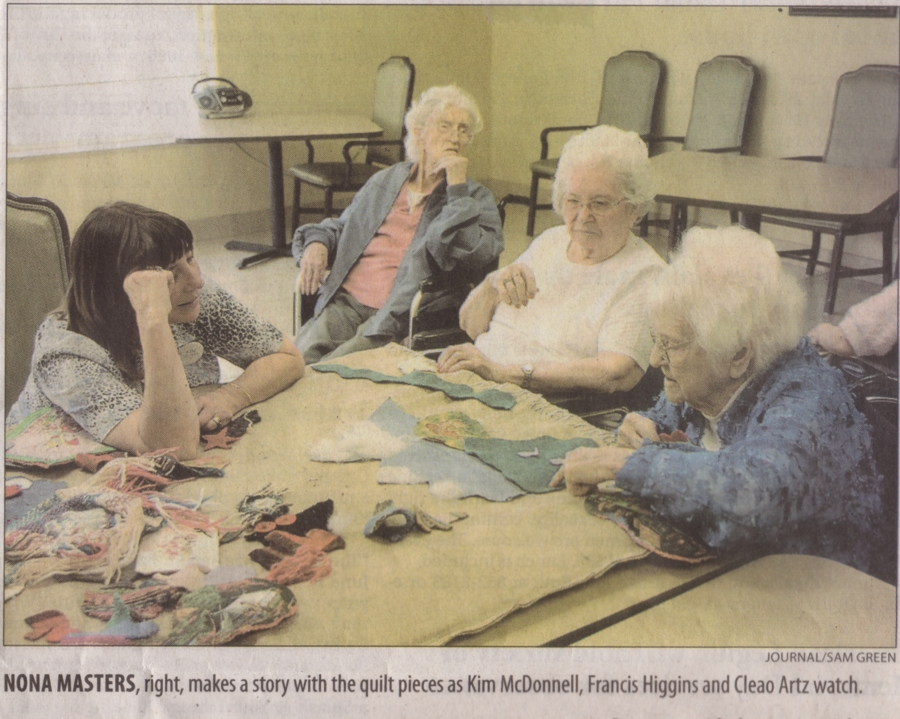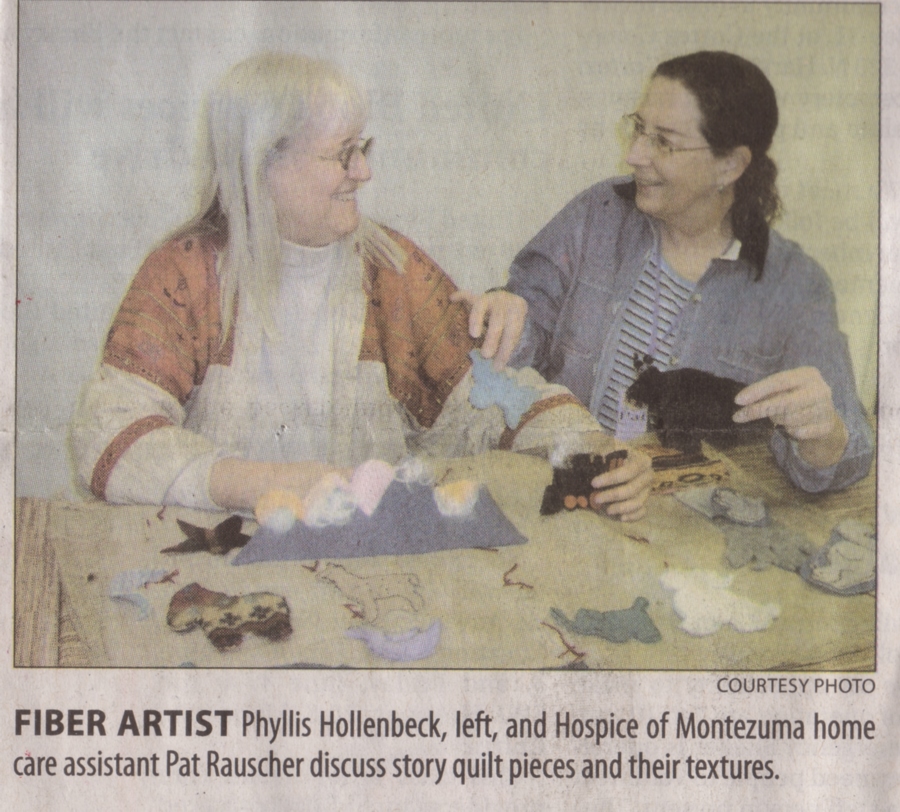Cortez Journal Article from May 29, 2010 (reprinted with permission from Cortez
Journal)
(Click on images to get full size image displayed)
Touch of Memory
Quilts help people with Alzheimer's remember
Past

Dementia is a loss of brain function that occurs with certain diseases. It affects
memory, thinking, language, judgment and behavior. One thing it doesn’t affect
is the sense of touch.
Some residents and patients with dementia at Vista Grande Inn care facility
and Hospice of Montezuma are using their sense of touch to help express and
remind them of their feelings.
They are doing this with the help of story quilts created by fiber artist Phyllis
Hollenbeck. The quilts are actually pillowcases or terry cloth towels. What
makes them special are the shapes she created to place on them that can be added
or removed and moved around to create a story.
“Telluride mountains are made out of blue jeans. An orange sweater from the
thrift shop looks like a sunset. I made a felted piece into the shape of a ’52
Chevy truck with orange pumpkins that can go in,” Hollenbeck said. “There are
sheep, donkeys and a plaid moon because who says a moon has to be white?”
The shapes, colors and textures can be used to help people with dementia remember
their stories.
Kathy Rousfet of Hospice of Montezuma, said patients feel the varied textures
of the shapes on the quilt and begin to talk about the sheep their family raised
or camping trips to the mountains.
The story quilts can also be used by caretakers or family members to tell stories.
A grandson’s picture can be traced and the outline can be cut out of one of
his shirts, glued to a terry cloth towel for thickness and be added to the quilt
(the other towel) as one of it’s story pieces. It can be a reminder for the
person with dementia of who the grandson is.
It’s very important that story pieces are thick and have weight, Hollenbeck
said.

“People with Alzheimer’s or arthritis have hands like padded gloves,” she said.
“I get old, real wool sweaters from the Salvation Army or Methodist Thrift Store.
I don’t use synthetics because there is no energy in the material. Wool is a
living thing. It has a wonderful texture and just feels good.”
Hollenbeck soaks old sweaters for 30 minutes in plain water to allow the central
core in each fiber to expand. That expansion opens up and releases dirt. She
then throws the sweater in the washing machine at maximum agitation with a cold
water rinse. The change in temperature makes the wool shrink and thicken.
She looks through children’s picture books to find shapes and then uses thin,
plastic cutting boards as templates to cut the sweaters into the shapes.
Hollenbeck suggested that caregivers who want to make their own story quilts
pick a cream-colored or tan towel as the background with dark shapes to help
people with vision problems see them better. She also suggested they not use
too many items on the quilt at one time because it will make it too busy and
confusing. The wool shapes stick to the towels and the quilt can be moved without
items falling off.
The idea for the quilts came as a request from Kim McDonnell, activity director
at Vista Grande. Hollenbeck was volunteering at the facility, teaching a weaving
program. McDonnell informed her the weaving wasn’t working because it was too
hard for residents with stiff hands. So Hollenbeck went home and thought of
the story quilt idea.
“It (the story quilt) was a hit from day one as a way of communication and storytelling,”
Hollenbeck said.
Hospice staff are excited about the story quilts and will explore if the pieces
can help people communicate the things they want. Someone with dementia might
not be able to remember the words to ask for a glass of water and become increasingly
agitated, but they might be able to pick up the shape of a glass of water on
the quilt to communicate their want. Similarly, Rousfet said, caregivers might
show the person a church, bathtub or table setting for a meal to explain what
they will be doing next. Instead of feeling frightened by things done to them
without warning, the shapes might express that it’s time for a bath or time
for lunch.
Both Hollenbeck and McDonnell stress that the story quilts are not only used
for those who can’t remember. Every resident at Vista Grande can enjoy the feeling
of the pieces and tell their stories.
It’s interesting how older people enjoy things they liked as a child, Hollenbeck
said. Many children’s books on library and bookstore shelves feature textures
and shapes for developing youngsters to learn words. Maybe that thought process
still works as we grow older and forget words.
“Validation in life when you’re in the elderly population is very beneficial,”
McDonnell said about Hollenbeck’s story quilts. “You want to remember and know
your life meant something.”
Hollenbeck will have specific information on how to make story quilts on her
Web site www.weavingtravel.com.
[Article written by Paula Bostrom, Cortez Journal Staff, Cortez, Coloardo]

